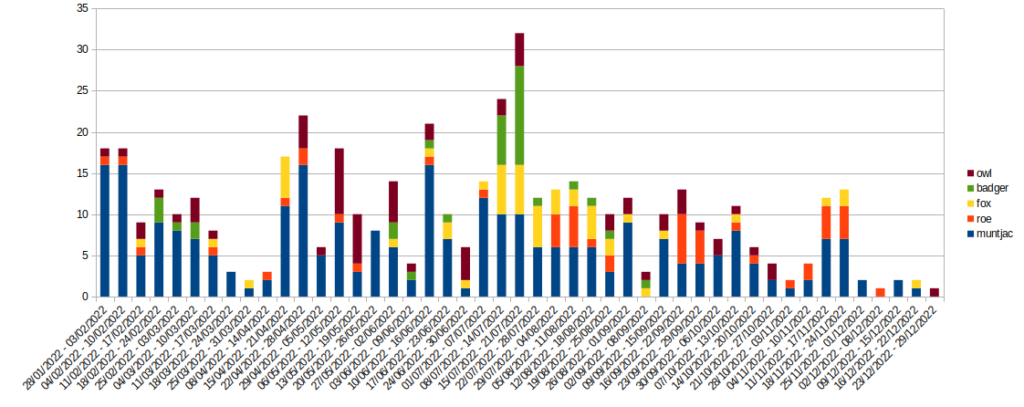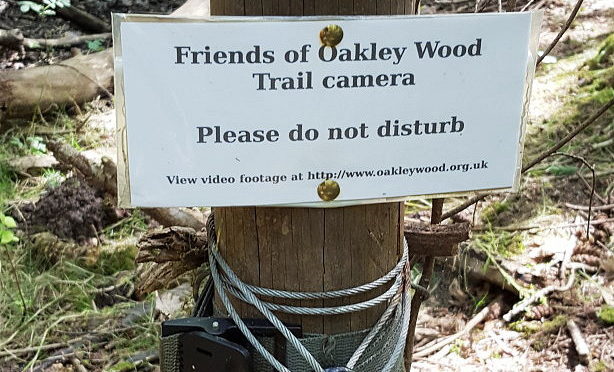As most of you will know, we have a trail camera in the wood. This has been positioned at the pond in the SW of the wood for some time, as this tends to be the most productive place for capturing wildlife.
I was lucky enough to spend almost two months in Australia during the end of last year and the beginning of this. Historically, the camera has captured around 40 video clips per week, perhaps 30 in a poor week, up to 70 in a good one. After such a long period away, I was expecting the camera card to be pretty full, maybe 300-400 clips. There were actually 71. After discarding the dogs, inquisitive people and a bizarre photo-shoot, that left 23 clips of wildlife. At first I thought there might be something wrong with the camera, but no.
Just 23.
Usually I discard most of the video clips from the camera: shots of nothing, perhaps triggered by a passing bird or wind-blown vegetation; an unidentifiable part of a something; another blurry image of a night-time muntjac, etc. I only keep clips that are potentially interesting enough to go on the website. So while I have clips going back years, they don’t form anything approaching a complete record of what’s been seen.
About a year ago, however, I decided to do just that, start keeping a daily record of what was captured even when I didn’t keep the video. I don’t record all species, just the ones I consider of interest, which includes deer, fox, badger, bat, most large birds (owl, buzzard, pheasant, duck of any variety) plus anything unusual.
The figures for 2022 look like this (click to enlarge):

Whilst it’s interesting to see the variation throughout the year, I’m not sure what conclusions could be drawn from it. It gets more interesting when there are figures that can be compared year-on-year. Since I started recording these in January 2022, I can compare the few weeks between January and now between 2022 and 2023, and they are quite revealing:


The reduction in sightings is startling. The most obvious difference is the lack of muntjac. Another is the sometimes lengthy periods when nothing was sighted. Previously there have rarely been days when nothing was recorded, but this winter there have been many such days, and even extended periods of up to a week or more. Unprecedented.
I can speculate on possible reasons…
Lack of muntjac
Most of the visits from muntjac were for drinking. Since the path improvements and creation of path-side scrapes, there are a lot more places in the wood for them to find water. The pond is in the SW corner of the wood – most animals would find other places to drink before getting there.
Lack of squirrels
I don’t record squirrels. I consider them uninteresting and a nuisance because they sometimes making up the majority of recordings, which I always throw away. Some days there may have been little else, hence an “empty day”. However, this winter there has been an almost total absence of them. I can’t think of a good reason for this. Dogs perhaps? Squirrels may disappear when dogs are around but soon return when they’re gone. So I don’t think this is a good explanation.
Dogs and people
There is undoubtedly an increase in the number of dogs and people visiting the wood. The reduction in wildlife may just be the inevitable result of this that we just have to accept as the cost of public amenity. The camera is seeing a consequential increase of dogs in the pond, which is unfortunate. We could consider (again) some signage around the pond asking walkers to keep their dogs away.
Thinning
The wood is much more open than it used to be, meaning there is less cover for larger animals. It’s been suggested that some (most?) of the larger animals live the the adjacent Wiggerland Wood during the day and only visit Oakley Wood at night, perhaps to drink (I don’t know if there is a source of water in Wiggerland). If this is what they do then they would definitely find water closer than the pond.
On the positive side (I think!):
- a pair of ravens have taken up residence in the wood, often to be seen and heard flying above it. Ravens have been around before, but perhaps not a pair.
- a pair of kites have been seen over the wood, much to the disapproval of the above!
- fallow deer have been recorded at the pond again recently.
That’s it for now. Take the opportunity to come and talk about this and any other wildlife topic at the AGM on Tuesday.
Chris

